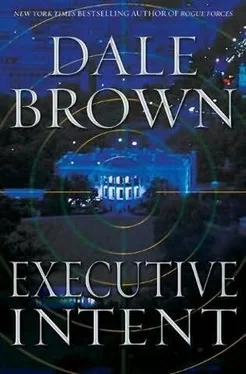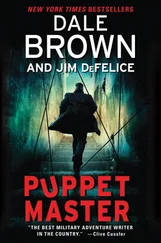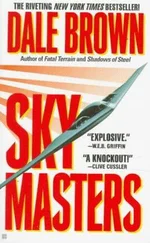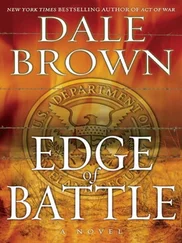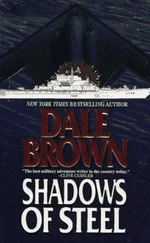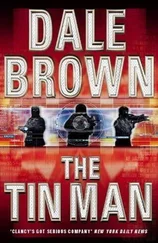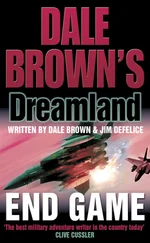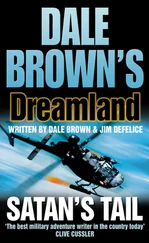“All stations, all stations, this is Armstrong, attack-commit authorization received,” the voice of Senior Master Sergeant Valerie “Seeker” Lukas said. She was at her monitor and tracking console in Armstrong Space Station’s command module. “All personnel, stand by.” To Kai Raydon beside her, she said, “All combat stations reporting manned and ready, sir.”
“Okay, kids, this is for real this time, but we do it just like we’ve rehearsed,” Kai said on the stationwide intercom. “Line it up, Seeker.”
“Roger, sir,” Lukas said. “Kingfisher Zero-Niner is responding to telemetry and reports ready, sir.” She turned to Raydon. “This will be a Mjollnir and ABM attack from the same platform at almost the same time, sir-I don’t think we’ve ever practiced that before.”
“Now’s a good time, Seeker,” Kai said. “I want to concentrate on the rocket. Have they launched any other Shaheens yet?”
“No, sir.”
“Then you can use more than one Trinity on the one in flight,” Kai said. “Hopefully we’ll nail the others before they launch. One Hammer should be more than enough for the ones still on the ground, but use another if you need to.”
“Yes, sir. Trinity One is counting down, twenty seconds to release. Hammer One is counting down, twenty-six seconds to release.”
As the Pakistani ballistic missile rose through the atmosphere, four hundred miles above it and six hundred miles behind it, the weapon garage named Kingfisher-9 emitted short thruster pulses in response to steering commands from its tracking and targeting computers. The cylindrical spacecraft had its own radar, electro-optical, and infrared sensors trained on the rocket, but the muzzle of the spacecraft was aimed well beyond it, along the computed flight path.
At the proper instant, the fire control computers launched the first Trinity interceptor vehicle. The kill vehicle used steering instructions broadcast from the weapon garage to insert itself into its own orbit that intersected the missile’s flight path. By this time the rocket motor on the Shaheen-2 ballistic missile had already burned out, and it was approaching its coasting phase at the top of its ballistic flight path. Even though it was a “tail-chase,” Trinity was traveling at orbital velocity of almost five miles per second and closed the distance to the vastly slower Pakistani missile in just eighty seconds. With ten seconds to intercept, the Trinity weapon activated its own millimeter-wave terminal guidance radar, refined its aiming with ultrashort bursts of thruster fire, and zeroed in for a direct hit.
Back on Kingfisher-9, immediately after launching the first Trinity vehicle, thrusters were already turning the weapon garage in a different direction, and as soon as the spacecraft was pointed properly, a Mjollnir vehicle fired-this one aimed toward Earth. Thrusters directed the payload on course. Specially shielded to withstand the extreme two-thousand-degree heat of reentry, slowing but still traveling more than four miles per second, the weapon package pierced the upper atmosphere in just over ten seconds.
As the superheated ionized air around the heat shield subsided, the shield was ejected, exposing the millimeter-wave terminal guidance radar aboard the payload guidance bus. The radar took digital pictures of the target area, comparing terrain features to its internal database for fine course corrections, then zeroed in on the target itself. In thousandths of a second it identified the target, measured the total target area, and computed the precise instant to release the titanium sabots. Small maneuvering vanes allowed some small course corrections, but the weapon was traveling too fast for the vanes to have much effect.
Seconds before impact, the sabots separated from the guidance bus, creating a radius of destruction precisely equal to the target area. The sabots hit the Earth traveling almost two miles per second, each with the force of a two-thousand-pound high-explosive bomb, creating a crater large enough to fit a jumbo jet within it…
…but missing the target area by over a mile, completely destroying a grain-processing facility on the outskirts of a village instead. Panicked by the massive explosion that erupted so close by, the terrorists abandoned the remaining two missiles and fled.
“It missed!” Bain shouted. “The other missiles are still alive.”
“But we got the one they launched,” Phoenix said happily. “We won’t have an interceptor to get the other ones if they launch, but-”
“What…just…happened…here?” President Gardner asked in a low, completely stupefied voice. His eyes looked up from the holographic imagery of the two nearly simultaneous attacks to the faces of the advisers around him. “Was that real?”
“Sir,” General Bain said, grinning like a kid at a circus, “it looks like we just took out a ballistic missile…with a weapon fired from space.” He pumped a fist in the air. “I don’t believe it myself, but they did it. They shot down a ballistic missile from space.”
The president looked at the chairman of the Joint Chiefs of Staff in utter disbelief, then with exasperation at his senior uniformed military adviser celebrating like a kid at a Little League game. “As you were, General,” he growled. “Who knows what we hit with those meteor things. This thing’s not over.” Bain lowered his eyes contritely, but not convincingly so. Gardner glared at Phoenix angrily. “I never should have fired those meteor things at Pakistan. That was wrong advice, and I shouldn’t have had to have it shoved in my face by you.” Phoenix said nothing, but returned Gardner ’s glare with a steady gaze.
“Mr. President, it appears the terrorists are abandoning those remaining missiles,” Kai Raydon reported from Armstrong Space Station. “They’re bugging out.”
“General Bain, make sure that space station stands down and doesn’t fire any more meteors at anybody!” the president said, drawing a finger across his throat to order the link cut off. To the State Department representative: “Send an immediate message to New Delhi, tell them the missiles have been abandoned and will soon be recovered, and urge them not to retaliate,” the president said. “Tell them the emergency is over. Get Mazar on the phone-call his office every ten seconds if you have to, but I want to talk to him immediately.”
He took a breath, swallowed hard, then added, “And I want to see Page and that general on the space station, Raydon, in the Oval Office as soon as possible. I want to know everything about those weapons. Then I want to meet with Secretary Barbeau and figure out what we’re going to say to the rest of the world when the news of what we’ve just done gets out. And someone shut this damned table off.”
The room began to clear out, but just as the vice president was leaving, Gardner said, “Mr. Phoenix, a word with you.” Ken Phoenix turned and returned to the Situation Room, along with Chief of Staff Kordus; the others wore expressions signifying they were happy to be leaving. “I’ll meet you in the Oval Office in a few, Walter,” the president said. Kordus glanced warily at the president, but nodded and departed, closing the door behind him.
“What was that, Phoenix?” Gardner exclaimed after the door was closed. “What the hell do you think you were doing?”
“My job, Mr. President,” Phoenix replied flatly.
“Your job is to take over for the president if he is unable to serve and to preside over the Senate, not to call up whatever military units you feel like and issue orders to the president of the United States! And you did it in the middle of a damned crisis, in front of my entire national security team. You undermined my authority and far overstepped yours.”
Читать дальше
